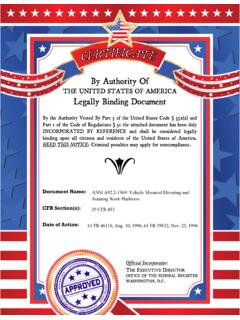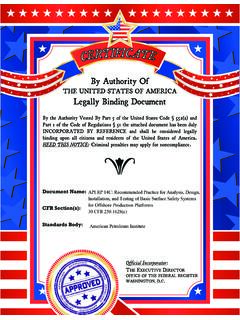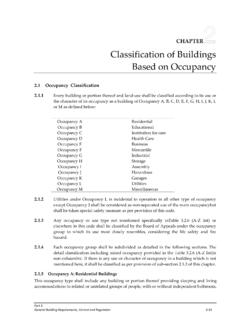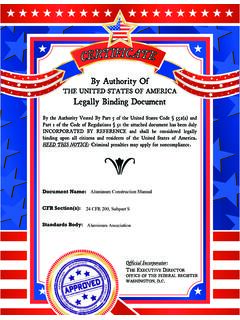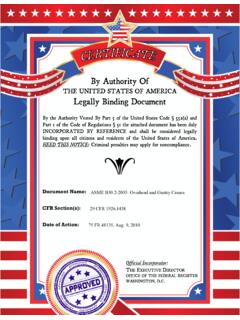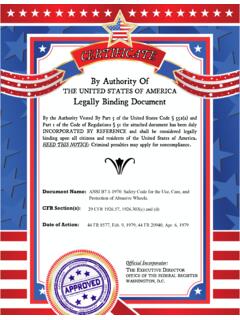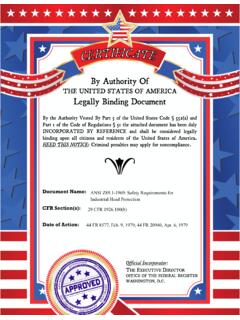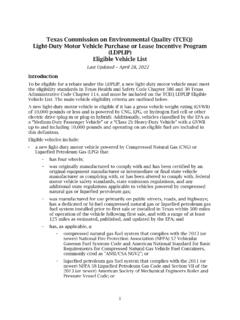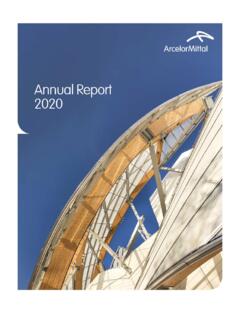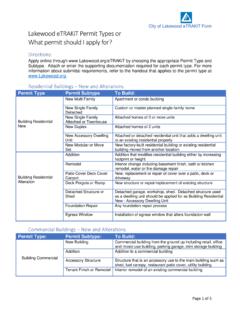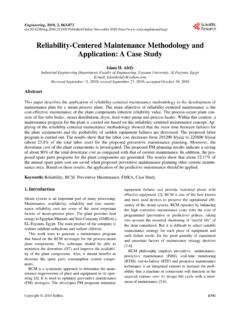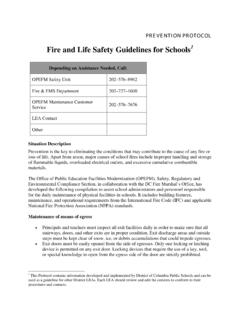Transcription of IS 3034 (1993): Fire Safety of Industrial Buildings ...
1 Disclosure to Promote the Right To InformationWhereas the Parliament of India has set out to provide a practical regime of right to information for citizens to secure access to information under the control of public authorities, in order to promote transparency and accountability in the working of every public authority, and whereas the attached publication of the Bureau of Indian Standards is of particular interest to the public, particularly disadvantaged communities and those engaged in the pursuit of education and knowledge, the attached public Safety standard is made available to promote the timely dissemination of this information in an accurate manner to the public. ! $ ' + - Satyanarayan Gangaram Pitroda Invent a New India Using Knowledge 0 1 ' 5 Jawaharlal Nehru Step Out From the Old to the New 1 + , 1 + Mazdoor Kisan Shakti Sangathan The Right to Information, The Right to Live !
2 > 0 B Bhart hari N ti atakam Knowledge is such a treasure which cannot be stolen Invent a New India Using Knowledge IS 3034 (1993): Fire Safety of Industrial Buildings :Electrical Generating and Distributing Stations - Code ofPractice [CED 36: Fire Safety ]IS 3034 : 1993 ( Reaffirmed 1998 ) Indian Standard FIRESAFETYOFINDUSTRIALBUILDINGS: ELECTRICALGENERATINGAND DISTRIBUTING STATIONS - CODE OFPRACTICE ( Second Revision ) First Reprint MAY 1999 UDC : : Q BIS 1993 BUREAU OF INDIAN STANDARDS MANAK BHAVAN, 9 BAHADUR SHAH ZAFAR MARG NEW DELHI 110002 August 1993 Price Group 8 Fire Safety Sectional Committee, CED 36 FOREWORD This Indian Standard was adopted by the Bureau of Indian Standards, after the draft finalized by the Fire Safety Sectional Committee had been approved by the Civil Engineering Division Council. A continuous supply of electric power is of primary importance to almost all human activities, particularly for the Industrial sector.
3 Fire or explosion in a power station may completely curtail supply of electrical power for considerable time in addition to causing extensive property damage to the building and equipment. Importance of fire Safety for the electrical generating and distributing stations has been increasingly recognised due to occurrences of several devastating fires in such premises in the recent past. Therefore, considering the fact that any fire in such occupancies may completely disrupt the life of the community, seriously hamper several il)flustries served by them, and also may involve replacement of highly valuable equipment, it is necessary that every attempt should be made to prevent or at least minimize the occurence of fires in these occupancies. Installation of equipment having built-in Safety measures in the premises and judicial suppression or isolation of fire risks will therefore reduce both the frequency of outbreaks of fire as well as contain its spread to other areas.
4 Further, with the adoption of suitable fire Safety norms with regard to design, layout and construction of Buildings and other structures, choice of materials for construction, etc, the premises can be rendered more safe from fire risk point of view. This standard was published in 1966 and revised in 1981. This second revision incorporates certain modifications based on the suggestions received from various organizations. Some of the important changes relate to provisions in respect of fire protection for turbo-generator Buildings , switch gear rooms, cable galleries, flammable oil storage, coal handling plants, transformer yards and such other hazardous areas. The important fire Safety and fire protection requirements for a power plant which should receive attention are given in this standard. Where necessary, references to relevant Indian Standards have also been made. Any fire Safety measures other than those covered in this standard, if prescribed in the relevant statutory rules and regulations should also be adhered to.
5 The Committee responsible for the preparation of this standard is given at Annex B. For the purpose of deciding whether a particular requirement of this standard is complied with, the final value, observed or calculated, expressing the result of a test or analysis, shall be rounded off in accordance with IS 2 : 1960 Rules for rounding off numerical values ( revised) . The number of significant places retained in the rounded off value should be the same as that of the specified value in this standard. Indian Standard IS 3034 : 1993 FIRE Safety OF Industrial Buildings : ELECTRICAL GENERATING AND DISTRIBUTING STATIONS - CODE OF PRACTICE / Second Revision ) 1 SCOPE This standard lays down the fire Safety require- ments regarding building construction, various process hazards and facilities, storage areas, etc, pertaining to electricity generating stations ( where electricity is generated from conven- tional sources using coal, oil, gas turbines, diesel generator sets, and the distributing stations ).
6 NOTE - This standard does not deal with the fire Safety requirements of nuclear power plants and hydro-electric power stations. 2 REFERENCES The Indian Standards listed in Annex A are necessary adjuncts to this standard. 3 GENERAL The main fire risk areas in a thermal power station are: a) Control room; b) Switch gear room; c) Cable ways and races; d) Coil and oil storage; e) Coal handling system belts; f ) Transformer houses; g) Coal houses; h) Coal mills; and j) Bunkers. including conveyor The following are also the areas having high damage potential in a thermal power station: 4 b) cl 4 Turbo-generator including lubricating and jacking oil systems, turbo-generator supporting structures and floor areas around the turbine; Hydrogen cooling and seal oil equipment; boiler feed pump turbine including lubri- cating and jacking oil services, and supporting structures including floor areas around the pump; Burner front areas of the boiler including fuel oil lighting up headers and pipe work 4 f) fit) h) j) basement floor immediately beneath the burner front, and the boiler casing area above the burner wind box; Oil filled generator, st ation unit and auxiliary transformers, reactor tranfor- mers including associated cooler and conversation tanks; Auxiliary boilers, oil burner pumps; Diesel driven pump/engine units and their fuel and storage tanks.
7 Bulk hydrogen stores; and Hydrogen generation plant. Apart from mechanical hazards of gas turbines, the hazards from fire mainly arise from fuel explosion fires due to leak in the fuel system or lubricating and seal oil systems. Surface temperatures of combustible chambers will be higher than ignition temperature of fuel and lube oil. The distribution stations such as load des- patch centres and sub-stations also cause fire hazards arising from oil-field transformers, switch gear, cable galleries/tunnels, etc. The planning for the fire protection scheme should start right from the design stage of the plant, thereby ensuring that adequate and suitable fire protection measures, both active and passive are incorporated not only while finalising the plant design itself, but right up to the compIetion In the fire protection system for the power plant, due consideration shall to the danger of smoke logging in all locations, in addi- tion to safeguarding against other likely gaseous toxic products, the provision of adequate means of escape shall also be given due consideration in the interest of life Safety .
8 4 BUILDING CONSTRUCTION AND RELATED REQUIREMENTS The structural elements of all Buildings of an electrical generating/distributing station shall be of Type 1 construction, complying with the requirements as given in tS 1642 : 1989. 1 IS 3034:1993 Provision for smoke ventilation, preferably of automatic type shall be made, over the gene- rator floor to permit escape of heat and large volumes of smoke likely to be generated. The requirements of fire venting shall conform to the provisions contained in relevant Indian Standards. A normal ventilation rate of minimum 2 cycles per hour shall be maintained for large area turbine halls. For extraction of smoke from fire, a volume change rate of 12 changes per hour shall be obtained depending on fire load, room height, size, etc. In case the start of the smoke extraction is delayed, the volume change rate shall have to be increased even up to 30 changes per hour.
9 Smoke vents of approved design shall be incorporated in cable tunnels/ galleries, plant rooms, switch board rooms, etc and provision made for the attachment of portable extraction unit, if not already served by a fixed smoke extraction installation. To achieve compartmentation, the plant shall be sub-divided into individual fire areas, to be maximum extent feasible. Reduce the spread of fire between such areas and the cons- equential damage, and also to achieve easy control and extinguishment of fire. Such sub- division by fire barriers or separation walls of minimum 2 hours fire resistance shall be provided in the following cases: a) b) cl d) f9 f) g) 4 3 k) ml Where turbine hall houses more than one unit, a fire barrier/separation wall shall be provided for each unit beneath the operating floor in the turbine and electri- cal bays; Between TG hall and control room/com- puter room/instrument room; Between TG hall and electrical switch- gear room ( unit-wise barriers needed ); Between the TG hall and cable galleries ( unit-wise barriers needed ); Between TG hall and boiler house; Between TG hall and coal pulverisers; Between TG hall and administrative building; Between staircases and lift shafts and the rest of the building; Between storage of flammable liquids and rest of the building.
10 Between transformer yard/outdoor trans- formers and other nearby building, in case a clear distance of 15 m is not avail- able; Between individual oil-field transformers containing oil in excess of 2 000 litres in case clear distance as specified in IS 1646 : 1982 is not maintained; n) Between battery rooms and other adjoin- ing areas, and p) Between cable galleries of each unit. The doors provided in the separation walls between these fire areas shall be self-closing fire-check doors of fire rating equal to that of the fire wall. Windows/Ventilators/Glass panels in fire separation walls (for example, for control rooms or computer rooms ) shall be provided with preferably clear fire resisting glass panels of minimum 45 minutes fire resistance or with automatic fire resistant shutters or automatic (water curtain. Cellular or foamed plastic materials ( such as expanded polystyrene, polyurethane foam etc ) shall not be used as interior finish or insu- lationin any part of the building.
